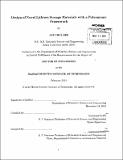Design of novel lithium storage materials with a polyanionic framework
Author(s)
Kim, Jae Chul, Ph. D. Massachusetts Institute of Technology
DownloadFull printable version (25.84Mb)
Other Contributors
Massachusetts Institute of Technology. Department of Materials Science and Engineering.
Advisor
Gerbrand Ceder.
Terms of use
Metadata
Show full item recordAbstract
Lithium ion batteries for large-scale applications demand a strict safety standard from a cathode material during operating cycles. Lithium manganese borate (LiMnBO₃) that crystallizes into a hexagonal or monoclinic framework is one prominent polyanionic compound to cope with such requirement since it can possess high safety and high energy density simultaneously, without trading one for the other, theoretically. However, the hexagonal phase was nothing but a disregarded composition due to its negligible Li intercalation capacity. In contrast, the monoclinic LiMnBO₃ compound exhibited much more electrochemical activity than the hexagonal polymorph. In this thesis work, the discharge capacity of 100 mAh g 1 with acceptable capacity retention was achieved by simple optimization. The different electrochemical behaviors between them were understood in relation to their structural difference as it affects the Li migration barrier, structural stability of Li-deficient states, and even particle morphology. However, although promising, monoclinic LiMnBO₃ needed further improvement in terms of the achievable capacity and cyclability. Electrochemical analysis showed that the limited capacity of LiMnBO₃ mostly originated from transport limitation, a hindered Li migration through the one-dimensional diffusion channel. It also struggled from the phase decomposition and Mn dissolution due to the instability of the delithiated state, which led to gradual capacity fading in prolonged cycles. As an effective materials design strategy to overcome such limitations, systematic substitution of transition metal elements was proposed. To increase achievable capacity, Mn was partially substituted by Fe. Also, to fortify the structural integrity, Mg replaced Mn. In order to obtain both improved capacity and cyclability, Fe and Mg are co-doping led to an optimized composition. Prepared by cold-isostatic pressing, LiMg₀.₁Mn₀.₅Fe₀.₄4BO₃ showed near theoretical capacity of 200 mAh g-¹ with much improved capacity retention. These newly established materials outperformed most of the polyanionic cathode compounds. Therefore, it can be concluded a new promising candidate as a Li storage material has been developed through this thesis research.
Description
Thesis: Ph. D., Massachusetts Institute of Technology, Department of Materials Science and Engineering, February 2014. Cataloged from PDF version of thesis. "February 2014." Page 206 blank. Includes bibliographical references (pages 195-205).
Date issued
2014Department
Massachusetts Institute of Technology. Department of Materials Science and EngineeringPublisher
Massachusetts Institute of Technology
Keywords
Materials Science and Engineering.